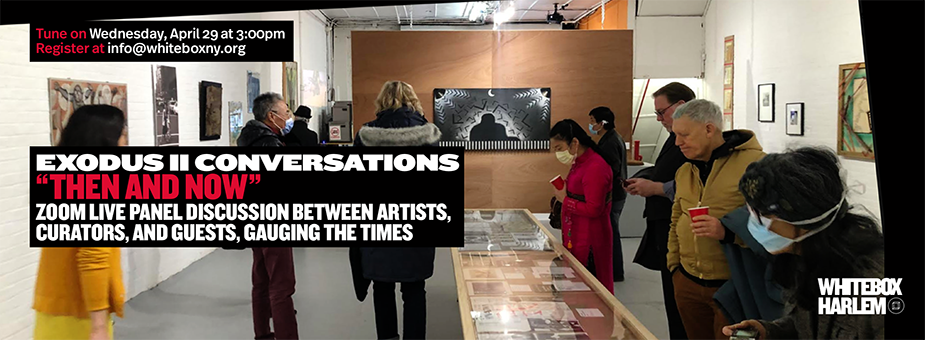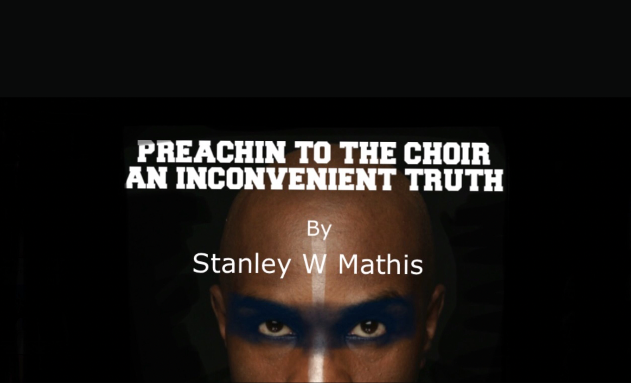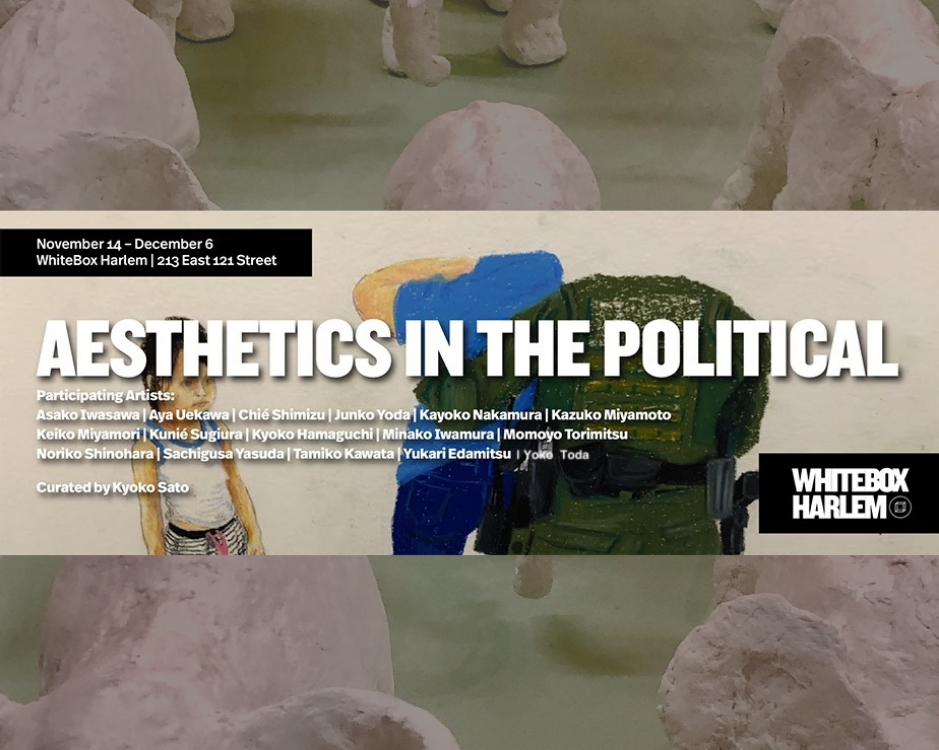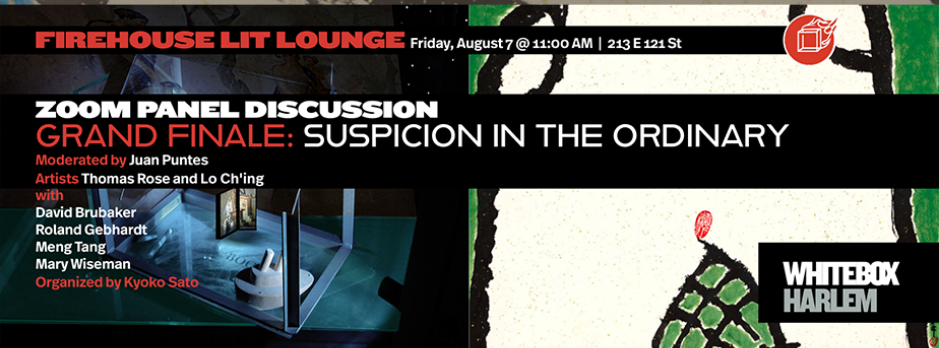EXODUS III: Mexico in New York: From Orozco to Orozco
April 3, 2020Nocturnal Whispers of Pan
June 3, 2020
Wed 29th 2020 – Live recording
–
Moderated by Anthony Haden-Guest
Conversation sponsored by WHITEHOT MAGAZINE
In the West an acceptance that Modern and Contemporary art are part on the world they live in has long been taken for granted at just about any social level. Indeed high-flying artists, avant-garde fireworks and giddy numbers have been staple mass media fare since Picasso, whether to be admired or snickered at, while a sequence of shows, such as Charles Saatchi’s Sensation in London and New York, keep provocative Contemporary art right in the public eye. In China, though, and especially the China in which most of these artists came of age, even the most curious had to rely for info about what was afoot in the artworlds of New York, London, Berlin, Paris, wherever, on what could be picked up from, say, occasional issues of Artforum passed from hand to hand.
Such minuses however can also work as pluses and one feature of Exodus II is what you won’t find there, nor among Chinese artists generally, namely the Retread-Modernism which is endemic in the Western art world, the pumping of avant-garde wells that no longer run fresh, like the showy sleight of hand that blossomed and withered as Zombie Formalism. Another feature is a presence rather than an absence. Western artists since the Impressionists and Cezanne have mostly – not all, but mostly – focused on painting, usually made in a way that forefronts painting as a physical act. There’s barely a smidgen of that painterliness with these artists. This, as Chinese art has always been, is drawing-based work.
These artists share something else, and this they share with Chinese immigrants generally, not just to New York but pretty much world-wide, which is that the city to which they came is embedded with a chunk of their homeland: Chinatown. And Manhattan’s Chinatown was particularly artist-friendly. The Basement Workshop, an avant-garde art hub sprung up there in the 60s. It was followed by the Epoxy Group, which was born in the Canal Street loft of Ming Fay, an Exodus artist, in 1982. The founders were six artists and two others also have work here, David Diao and Bing Lee.
Bing Lee’s family moved from China to Macao when he was a child. and he went to high school in Hongkong. ”It was an international city,” he says “So I got these influences, the East and the West, when I was a child. I listened to the Top Forty. I looked at the National Lampoon and Mad Magazine”. Listed as a member of Epoxy, he somewhat resists that description. “We were a collective, we didn’t have members,” he said. “We just chipped in to secure the projects”.
Lee left Epoxy in the wake of their last project, 18 Levels of Hell, and was part of the group that created their successor. “We have a Tuesday lunch club,” he said. “A bunch of artists get together and not just artists. Critics, curators. We meet in a Chinatown restaurant. The criterion is that the food has to be good and affordable and the waiter, waitress has to leave us alone. We can sit there for hours.”
That would become Godzilla or, more fully, Godzilla – Art Network, which cast a wider net than Epoxy, bringing in Asian-American artists generally, including Japanese and Korean-Americans, Filippinos and Pacific Islanders, and it took its name from the Japanese pop movie phenomenon to indicate the strength of the personal bonds between the artists. Which also specifically distinguishes Chinese-American culture and owes much to a shared language, but also to shared belief systems. As when Ming Fay makes fruit a central subject of his paintings and is explicit about the connection. “My art is informed and grounded in a Taoist philosophy which considers human beings a part of nature and coexisting in harmony with nature,” he says, and ticks off a few specific associations. ”Pears for prosperity, peaches for longevity, oranges for good luck and cherries for love.” Jon Tsoi likewise channels Tao when speaking of the work he makes blindfold. “I make art to see inside myself without eyes,” Tsoi says. “I am always working with the Yin and the Yang.” These are the halves that make up Taoist wholeness,. “Yang is hot, Ying is cool,” he says. “I try to take out the personal. I use body energy, universal energy. Working blind-folded forces you to look at the inner spirit”.
Does this indicate a distinction between Chinese and Western artists, not just in their practices, but deeply rooted? We should avoid all generalisations – and, yes, that’s a generalization too – but I will note that the late Guangzhi Zhang, a professor of archaeology at Harvard, proposed in a 1999 essay that China has had a “continuous civilisation”, like that of the Mayas, whereas the characteristic Western model ever since ancient Sumer has been the “breakthrough civilization” or “rupture civilization”.
Which defines the Cultural Revolution as just a violent hiccup? If so, it was one of which many of the Exodus artists had first hand experience. “At the beginning of the Cultural Revolution I really trusted Chairman Mao,” says Zhang Hongtu. “There was something really romantic, an idealism. I trusted him. But I realized he wanted to build himself up like a god for the Chinese people. China has always been seriously religious, the whole country. There is Confucianism, Taoism, Muslims. But Mao Tse Tung wanted to make himself a god. That changed my ideas.”
Then came the Cultural Revolution. Hongtu’s father was a Muslim, and an Arabic scholar, so the family were, of course, denounced. His uncle was killed, the body flung into a river. “I saw people kill each other” he says. He had an excellent job as a jewelry designer but threw it up and managed to get to New York in 1982, where he supported himself by construction jobs and painting walls. “I really wanted to forget about China,” he said.
Then came the Tiananmen Square massacre of 1989 and history came flooding back. “I tried to make some new work about my memories and my experience. And my life under Mao during thirty years in China,” Hongtu says. That August he made his first Mao portrait, a collage, then went on to transfer the Chairman’s portrait to a Quaker Oats carton. This body of work got Zhang Hongtu art world attention and one of his new pieces, a re-make of Leonardo’s Last Supper, featuring the Chairman in Christ’s seat surrounded by Maoist disciples, was chosen to go on show for the first anniversary Tiananmen Square by the Congressional Human Rights Foundation in Washington, D.C. It’s a supreme irony that it was finally given a thumbs down because it “offended Christian values.”
Yin Mei also had a taste of Maoism in her youth. “During the Cultural Revolution there was no art,” she says. “It was considered reactionary to the revolutionary mind.” Her mother and father came under pressure aa suspect “rightists”. So at the age of 14 she ran away to join the Cultural Revolution in Wujan. Some of the many letters she wrote her parents form part of Exodus II, as what you might describe as found objects presented as Conceptual art.
Excerpts from the first, written on Chinese New Year’s Eve, 1971, read as follows:
Dear Dad, dear Mom and dear brother East Rising:
I was issued all of my military uniform today. On the Eve of the Chinese New Year I became a real Artistic Warrior for Chairman Mao in the Revolutionary Army … I heard from the political commissar that you have been under a lot of pressure… They dare not bully you anymore because I’m not doing anything counter-revolutionary. Instead, I am going to participate in the revolutionary army led by Chairman Mao. Also: On New Year’s Day, eight Artistic Warriors sat at a round table. The military we visited made a lot of dishes for us. They even killed two pigs to feed us and celebrate the New Year. We had performed 8 shows during the Spring New Year Festival. Someone took photos of us during our performance the night before. .
Mom, I bought a washbasin with pattern of a little panda. It cost me 2.79 Yuan, and it looks so pretty.
So Yin Mei had become an Artistic Warrior. I pointed out that she had told me art was considered counter- revolutionary. Not if the art told tales of revolution, she explained. Such as the two ballets created by Chairman Mao’s wife, The Red Detachment of Women and The White-Haired Girl. She danced frequently in both. “So the entire country was only watching these two ballets for ten years,” she says. She got to New York in the 80s and both dances and runs a dance troupe there to this day.
The politics of those times in China have been followed by further shock-waves – Tiananmen, Hongkong, Wuhan – and these have sensitized emigre artists, not only to a felt need to involve themselves with the flow of political event, as when Jon Tsoi would preface his performances with a declaration during the suppression of student protests in Hongkong, but also to making the political process into part of their art material. The paradigmatic example of both strategies, of course, being Ai Weiwei, who began in New York drawing portraits on the streets, who has been turning out strong individual works but who has also turned his whole life into an exemplary and necessarily risky work of Performance art.
Xu Bing also has lived through politics and contrived to turn it into art. His father was a scholar. “And my mother used to work in library studies,” he says. “I was in a sea of books. It was a very intimate experience. But I was a child. I had no idea what was in the books. The contents and the appearances didn’t match each other … it was the textures … the covers … the paper. It was vivid and sensual.” Came the Cultural Revolution. “There were not so many books. It was like going back to the Quin Dynasty,” he says, referring to the period that supposedly saw libraries committed to the flames and 460 Confucian scholars buried alive. “We are burning the books! We bury the intellectuals! Scholars got killed.”
Xu Bing arrived in America in 1990. Much of his work centers on books but in a way that reflects his childhood experience of them. “I have curated a show about art books,” he said. “Books for people to read have been replaced by iPads, everybody reads screens So now a book is more an object. In this scenario the appearance of a book plays the greatest part.” Book from the Sky, a piece he made between 1987 and 1991, consisted of several hundred bound books, bound in the traditional manner, their texts being printed from wooden blocks, hand-carved with 4,000 convincing Chinese characters. But they were nonsense characters, void of meaning. 4,000 of them though. Assistants would have had to be involved, right? Wrong. “I didn’t have any assistants,” he said. “I visited old craftsmen and I used very ancient tools. I invented s system of carving for myself.”
A gift for making art out of highly charged event reached an apogee after Xu Bing had seen the destruction of the World Trade Center from his studio window. He went around a Lower Manhattan in aftershock, collecting dust, and went on to make an installation, a dusty shimmer within which can be read the Zen Buddhist verse from which the piece gets its name: Where Does The Dust Itself Collect? This has been shown world-wide and brings up an interesting point. American artists have, with exceptions, been as wary of dealing with 9/ll as Superman was of kryptonite but emigré Chinese, conditioned perhaps by extreme events in their homeland, clearly feel fewer such constraints. Yan Li, the artist /poet, whose work you will see here, tells me he has written “a small novel” about the event.
Ai Weiwei was not the only Chinese émigré artist to establish a presence outside the art world. So too did Tseng Kwong Chi but in a wholly different world. His father had been in the Nationalist Army, then made it to Hongkong, where Tseng and his sister Muna were born. Tseng decided to be a photographer early, Muna to be a dancer. Then their mother went to London and saw Margot Fonteyn dance at Covent Garden. “She came back to Hongkong and said you are not taking ballet class with second rate teachers” Muna says.
The family moved to Vancouver in 1966 and Muna did finally study ballet. While Tseng studied photography in Paris. Brother and sister went to New York and shared an apartment in 1978. He was 28, she. *** years younger, he to become a working photographer, she to become a dancer. Tseng would soon be very much part of the art world of the Lower East Side, a member of Club 57, on friendly terms with a group which included Kenny Scharf, Ann Magnusson, Rene Ricard and especially Keith Haring. He would take group photographs and, in due course became Haring’s personal photographer. He also launched on a series of photographs of artists in their studios, including Jean-Michel Basquiat. “That was in his studio in Great Jones Street,” Muna says. “He actually styled Jean-Michel” Muna says. “He would say Pose with this coffee mug on top of this painting … and hold your paintbrush there. He would compose it like a fashion shoot.”
Tseng also picked up magazine work, such as assignment to cover Diana Vreeland’s Costume Institute Gala at the Metropolitan Museum in 1980 for the SoHo Weekly News. “He put his camera on a tripod,” Muna says. “And as guests came in he would interview them about being at the party, how they were feeling, what they were wearing. And he would pose with the guest.” Pose being a well-chosen word because Tseng would be wearing the cheap gray Mao suit he had picked up at a Montreal thrift store, an artful piece of self-branding, which had become his usual working outfit. Yves Saint-Laurent approached for his camera moment. “He posed, they were speaking in French,” Muna says. “And Yves Saint Laurent said you speak French so well. You must be an ambassador from China. This was 1980. It was the second year he was wearing his Mao suit photographing. So it was a really pivotal moment. And he started calling himself The Ambiguous Ambassador. And then he did the Costumes at the Met series.”
Another of Tseng’s projects was the Monument series, which occupied him for ten years, these being self-portraits in the Mao suit, partnered by such visually familiar chunks of reality as the Brooklyn Bridge, a Mickey Mouse, an astronaut fronting a space module, Mount Rushmore, and such now heavily loaded sites as Notre Dame and the World Trade Center. Tseng Kwong Chi, who died of AIDS a few months after Keith Haring, truly put himself out there. As does the whole of Exodus II.
–
ANTHONY HADEN-GUEST
Emigre Artist and the New York Vanguard
Curated by Elizabeth Rogers, Bing Lee and Anthony Haden-Guest
Contributors
Juan Puntes – Kyoko Sato – Alejandro Penafiel
Participating Artists
Bing Lee ・ David Diao ・ Jon Tsoi ・ Kwok Mang Ho ・ Ma Kelu ・
Ming Fay ・ Szeto Keung ・ Tehching Hsieh ・ Tseng Kwong Chi ・ Wucius Wong・Xu Bing・ Yan Li ・ Yin Mei・ Zhang Hongtu




